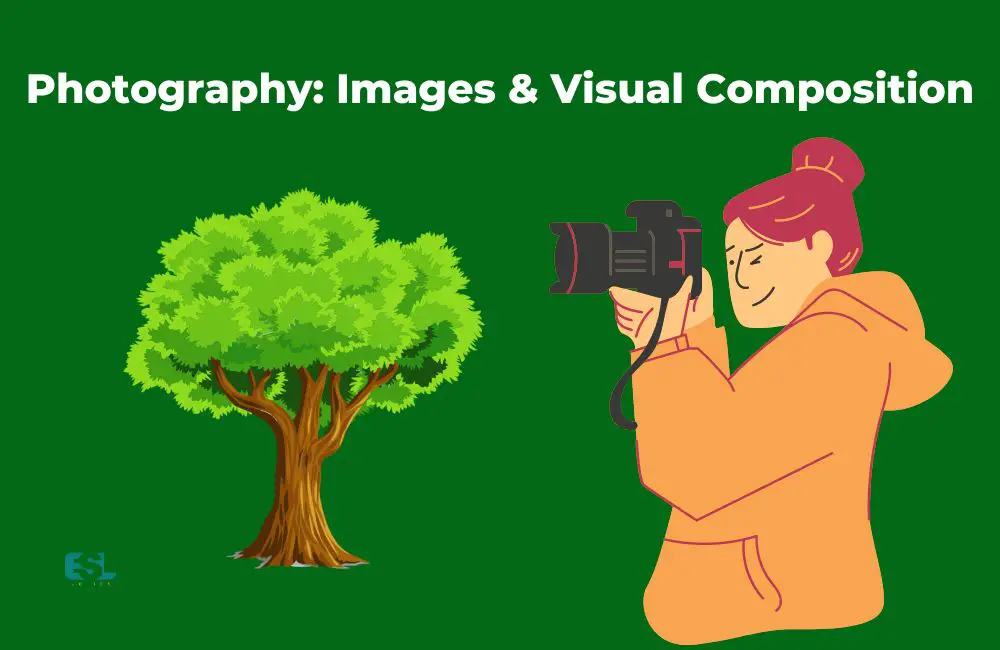Understanding photography requires more than just a good eye and a quality camera; it also involves a certain level of familiarity with the related terminology. Whether you’re an aspiring photographer looking to hone your skills, a professional looking to enrich your vocabulary, or simply an enthusiast interested in the craft, this guide is designed to help you navigate the fascinating world of photography.
With a focus on vocabulary related to images and visual composition, this article will take you through key terms that will help you both understand and articulate your photographic journey better.
Table of Contents
- 1. Basic Photography Terms
- 2. Types of Photography
- 3. Visual Elements
- 4. Photography Techniques
- 5. Photography Equipment
- Sample Conversation: Using Vocabulary Related to Photography
- Conclusion
- FAQ: Vocabulary Related to Photography
1. Basic Photography Terms
This section introduces the basic terms used in photography, providing a foundational understanding of photography’s core concepts.
| Word/Phrase | Meaning/Usage | Example Sentences |
|---|---|---|
| Aperture | The opening in a lens through which light enters the camera | “By adjusting the aperture, you can control the depth of field in your image.” |
| Shutter speed | The length of time the camera’s shutter is open and exposing light into the camera sensor | “Using a fast shutter speed can freeze motion, while a slower speed can create a blur effect.” |
| ISO | Camera setting that affects the sensitivity of the camera’s sensor to light | “Increase the ISO to capture brighter images in low light conditions.” |
| White balance | The process of removing unrealistic color casts, to make the image more accurate | “I set the white balance to match the cloudy conditions.” |
| Exposure | The amount of light that reaches your camera sensor | “Correct exposure is a balance between aperture, shutter speed, and ISO.” |
| Focus | The clarity or sharpness of an image | “I used manual focus to ensure the bird was in sharp detail.” |
| Depth of field | The distance between the nearest and farthest objects that are in focus | “A shallow depth of field can be used to isolate the subject from the background.” |
| Frame | The edges of the image, or what is visible in the image | “The tree branches formed a natural frame around the sunset.” |
| Composition | The arrangement of elements within a photograph | “Good composition can transform an ordinary scene into a great photograph.” |
| Perspective | The relationship of objects within an image, especially relative to the viewer’s viewpoint | “Shooting from a low perspective made the building appear taller.” |
| Rule of thirds | A principle of composition that divides an image into thirds horizontally and vertically | “By positioning the horizon along the top third line, I followed the rule of thirds.” |
To elevate your vocabulary in just 30 days, I recommend to my students an informative, fun, and accessible guide to utilizing powerful language. Millions of individuals have enhanced their academics, job skills, and confidence by dedicating just fifteen minutes daily to the exercises and tests of 30 Days to a More Powerful Vocabulary (Amazon Link), a top-selling. It offers step-by-step methods to bolster language prowess, discover compelling words, and daily vocabulary enhancement with pronunciation guidance.
2. Types of Photography
There are many genres and styles of photography, each with its unique approach and requirements. Here are some of the most common types.
| Word/Phrase | Meaning/Usage | Example Sentences |
|---|---|---|
| Portrait | Photography that focuses on a person or group of people | “She specializes in portrait photography, capturing the essence of her subjects.” |
| Landscape | Photography that captures scenes in nature | “His landscape photographs show the beauty of the desert.” |
| Macro | Close-up photography that captures small subjects in great detail | “Macro photography reveals the intricate details of flowers and insects.” |
| Street | Candid photography that captures everyday life in public spaces | “His street photography captures the bustling life of the city.” |
| Wildlife | Photography that captures animals in their natural habitats | “Her wildlife photography showcases the beauty and brutality of nature.” |
| Aerial | Photography taken from an elevated or high viewpoint, often using drones | “Aerial photography provides a unique perspective on landscapes and cityscapes.” |
| Underwater | Photography taken while submerged in water, often requires specialized equipment | “His underwater photographs reveal the vibrant life beneath the sea’s surface.” |
| Architectural | Photography that focuses on buildings and structures | “Her architectural photography emphasizes the geometric patterns in skyscrapers.” |
| Astrophotography | Photography that captures celestial bodies and events | “Astrophotography requires a clear night sky and long exposures.” |
| Fashion | Photography that focuses on clothing and fashion items, often in the context of advertising or fashion magazines | “Fashion photography often involves collaboration with models, designers, and stylists.” |
3. Visual Elements
Visual elements are the building blocks of a photograph’s composition. Understanding these elements can greatly enhance the impact of your images.
| Word/Phrase | Meaning/Usage | Example Sentences |
|---|---|---|
| Line | A visual path that enables the eye to move within the picture | “The winding road created a leading line that draws the eye into the image.” |
| Shape | The external outline of a form or anything in two dimensions | “The silhouettes created distinct shapes against the sunset.” |
| Form | The representation of three dimensions, height, width, and depth, in a two-dimensional image | “The strong side lighting revealed the form of the mountains.” |
| Color | The visual perception of different wavelengths of light, identified as red, green, blue, etc., and their variations | “The vibrant colors of the flowers made the image more appealing.” |
| Texture | The visual and tactile quality of the surface of an object | “The close-up shot emphasized the texture of the tree’s bark.” |
| Pattern | An arrangement of repeated or corresponding parts, whether similar or not | “The pattern of the tiles added interest to the photograph.” |
| Contrast | The difference in luminance or color that makes an object in an image distinguishable from another | “The contrast between the dark shadows and bright highlights added drama to the image.” |
| Negative space | The empty or open space around an object that defines it | “Using negative space can make the subject stand out.” |
| Symmetry | A balanced arrangement of similar or identical elements | “The symmetry of the building’s façade created a pleasing composition.” |
| Balance | The distribution of visual weight within a photograph | “The image feels balanced with two subjects on either side of the frame.” |
4. Photography Techniques
There are numerous techniques in photography that can be used to enhance the visual impact of an image. Here are some commonly used techniques.
| Word/Phrase | Meaning/Usage | Example Sentences |
|---|---|---|
| Long exposure | A technique that involves using a long-duration shutter speed to sharply capture stationary elements while blurring or obscuring the moving elements | “Long exposure photography can make waterfalls look silky and ethereal.” |
| Bokeh | The aesthetic quality of the blur in the out-of-focus parts of an image | “The bokeh created by the wide aperture made the subject stand out.” |
| Panning | A technique that involves moving the camera horizontally to follow a moving subject, resulting in a blurred background but a sharp subject | “Panning is often used in sports photography to emphasize motion.” |
| High dynamic range (HDR) | A technique that involves combining multiple images with different exposures to create a photograph with a wider dynamic range | “HDR can reveal details in both the shadows and highlights of a high-contrast scene.” |
| Burst mode | A feature on some cameras that takes several photos in rapid succession | “Burst mode is useful for capturing action or unpredictable moments.” |
| Time-lapse | A technique where the frequency at which film frames are captured is much lower than that used to view the sequence | “A time-lapse video can show a flower blooming or a sunset.” |
| Tilt-shift | A technique often used to create a miniature effect, making the scene appear smaller than it is | “Tilt-shift photography can make a cityscape look like a model village.” |
| Low-key | A style of photography that utilizes predominantly dark tones to create a dramatic, moody image | “Low-key lighting can create a dramatic portrait.” |
| High-key | A style of photography that uses unusually bright lighting to reduce or completely remove dark shadows | “High-key lighting can create a light, airy image with minimal contrast.” |
| Silhouette | A technique where the subject is seen as a black shape without detail against a brighter background | “A silhouette can be created by shooting against the light.” |
5. Photography Equipment
Understanding the equipment used in photography is crucial for both the technical and creative aspects of the craft.
| Word/Phrase | Meaning/Usage | Example Sentences |
|---|---|---|
| DSLR | Digital Single-Lens Reflex camera, a type of digital camera that combines the optics and mechanisms of a single-lens reflex camera with a digital imaging sensor | “DSLR cameras offer interchangeable lenses, allowing photographers more flexibility.” |
| Mirrorless camera | A type of camera that works without a reflex mirror, light travels directly from the lens to the digital sensor | “Mirrorless cameras are typically lighter and more compact than DSLRs.” |
| Prime lens | A lens with a fixed focal length | “A prime lens often provides superior image quality compared to zoom lenses.” |
| Zoom lens | A lens that allows you to change the focal length, giving you a range of flexible framing options without changing the lens | “A zoom lens is versatile and useful for different types of photography.” |
| Wide-angle lens | A lens that has a substantially wider field of view than a normal lens | “A wide-angle lens is ideal for landscape and architectural photography.” |
| Telephoto lens | A lens with a long reach, providing a high level of magnification, allowing you to photograph subjects at a distance | “Wildlife photographers often use telephoto lenses to capture animals without disturbing them.” |
| Tripod | A three-legged stand used to stabilize and elevate a camera | “A tripod is essential for long exposure and landscape photography.” |
| Flash | A device used in photography producing a flash of artificial light to help illuminate a scene | “Using a flash can help illuminate subjects in low light conditions.” |
| Light meter | A device used to measure the amount of light in a scene | “A light meter can be helpful for achieving correct exposure.” |
| Filters | Transparent or translucent glass or gelatin elements that modify the light entering the lens | “A polarizing filter can help reduce reflections and enhance colors in a scene.” |
If you are looking for an effective English language vocabulary builder, try Word Power Made Easy: The Complete Handbook for Building a Superior Vocabulary (Amazon Link). This time-tested classic has helped millions achieve mastery of English and improve their communication skills in business, the classroom, and in life.
Sample Conversation: Using Vocabulary Related to Photography
Situation: At a photography exhibition, seasoned photographer, Olivia, discusses her work with Neil, a budding enthusiast.
Olivia: Neil, I noticed in your recent shots you’ve been experimenting with depth of field. It’s a fantastic way to draw attention to your subject.
Neil: Thanks, Olivia. I’ve been trying to understand the relationship between aperture and shutter speed. It seems they’re crucial for achieving the desired exposure.
Olivia: Absolutely. A wider aperture lets in more light and gives a shallower depth of field. Meanwhile, shutter speed determines how long your sensor is exposed to light. Balancing the two is key.
Neil: I’ve been struggling with capturing motion, especially in low light conditions.
Olivia: You might want to experiment with long exposure shots. They can create a beautiful blur effect for moving subjects. Just ensure your camera is stable, perhaps using a tripod.
Neil: Great advice! I’ve also been interested in macro photography. Any tips on that?
Olivia: Macro photography is all about capturing small subjects in great detail. A dedicated macro lens can help. Also, consider external lighting sources to illuminate details.
Conclusion
Photography is a complex art with its language, just like any other discipline. Understanding this vocabulary is essential in improving your photographic skills, whether capturing moments for your enjoyment, honing your skills as a professional, or engaging in meaningful conversations about the craft.
As you continue to learn and grow in your photography journey, these terms will become second nature. Happy shooting!
FAQ: Vocabulary Related to Photography
1. What is depth of field in photography?
Depth of field refers to the range in a photograph where the subject is in sharp focus, while everything in front of and behind it is blurred.
2. How does aperture impact an image?
Aperture determines the size of the lens opening, controlling the amount of light reaching the camera sensor. A larger aperture (smaller f-number) lets in more light and creates a shallower depth of field.
3. What role does shutter speed play in capturing images?
Shutter speed is the duration for which the camera sensor is exposed to light. Faster shutter speeds freeze motion, while slower speeds can capture motion blur.
4. How does one achieve proper exposure in photography?
Proper exposure is achieved by balancing aperture, shutter speed, and ISO settings. It ensures that the image is neither too dark (underexposed) nor too bright (overexposed).
5. Why are tripods used in photography?
Tripods provide stability to the camera, preventing shake and allowing for sharper images. They’re especially useful for long exposure shots.
6. What is macro photography?
Macro photography involves capturing close-up shots of small subjects, revealing details that might be missed by the naked eye.
7. How can composition influence a photograph?
Composition refers to the arrangement of elements within a frame. Good composition can guide the viewer’s eye, making the image more engaging and impactful.
8. Why is lighting crucial in photography?
Lighting affects the mood, clarity, and tone of an image. Proper lighting can highlight details, create depth, and enhance the overall quality of a photograph.
9. What is the rule of thirds in photography?
The rule of thirds divides an image into nine equal sections using two horizontal and two vertical lines. Placing key elements along these lines or at their intersections can make photos more balanced and visually appealing.
10. What are RAW files in photography?
RAW files are uncompressed image files that capture all data from the camera sensor. They provide more flexibility in post-processing compared to JPEGs, allowing for better quality edits.






